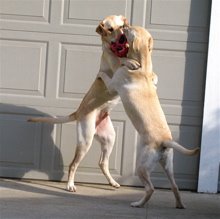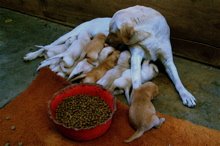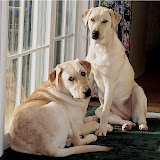A "Tired Dog" is a "Good Dog"
And now back to our regularly scheduled topic.
When you own a dog, not to mention a big dog, and he just happens to be a reactive big dog, you are very familiar with the idea that "a tired dog is a good dog." That being said, be very careful just how quickly you jump to this solution. The phrase should really be "a calm dog is a good dog." When I say calm I mean a dog that has self control, a dog that can self calm, one that can modulate it's own behavior on command. At the very least it is a dog that will hold a neutral position whether that is a "sit" or a "down" despite being excited, until they are calm.
When I started classes with Trish I figured that exercising them before class would help. It totally backfired on us. Instead of being easier to direct Shelby was even more "ampted" up.
My girlfriend who has a "reactive" female Labrador decided to put her in agility. The logic being that it would focus her energy and give her an outlet for all her extra energy. Her dog did well but in her second class she was bit by one of the other dogs. There are so many things that should have been done differently to avoid her dog getting bit but that's not the point here.
My point is however that an easily over excited dog should not have another over stimulating outlet for their energy until they have a bit more self control. If you want to hear from the experts as to what this should look like check out these great resources:
Guidelines For Teaching Self Control, by Suzanne Clothier
Understanding & Teaching Self Control, by Suzanne Clothier
At our house it looks like the following:
- Both dogs have to go to their bed and lie down quietly before each meal time. (Quietly being the operative word here when it comes to Shelby.)
- Even after their food is served they must wait until I give them the release command which in our house is simply "Release"
- If one dog is getting affection the other can not push in. They are told to "sit" and "wait". Whining and vocalizing gets them nothing but the command to "be quiet". Sometimes I have walked away without giving Shelby even a pat if he has been exceptionally demanding
- If we are going somewhere and they have gotten over excited they have to sit at the open door until they are calm and quiet before I "release" them outside.
- If they are overexcited and barking when we get to the park they have to lay down and not until they are quiet are they "released" out of the car.
- Our dog park is double gated at the entrance. My dogs have to hold a "sit stay" with their leashes off so I can go and open the second gate. They don't move to enter the park until they are "released".
One more point to keep in mind is that your dogs will take thier cues from you. It's hard wired into thier instincts as pack animals. When you raise your voice or talk sharply, a dog hears this tone as being excited, similar to barking. Realize that it will only reinforce their already excited behavior, and give them the idea that you are excited too, so it must be okay! Instead speak softly and in quiet tones to get your dog to calm down, and they'll realize soon enough it's not appropriate behavior for the situation.
Trust me this is not an easy thing to always practice when you own a "reactive" dog. They seem to be able to go from "zero to crazy" in a split second all on their own. I continue to struggle with keeping my voice calm everyday. That being said, it's good to keep reminding myself what my focus should be and why. Hopefully it will help you too, if you as well find yourself with a dog that needs self control as much as they need exercise.















1 comment:
Excellent information!
Post a Comment